
Equipment of the Canadian Coast Guard
Encyclopedia
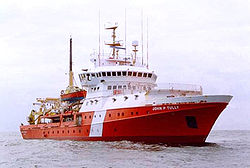

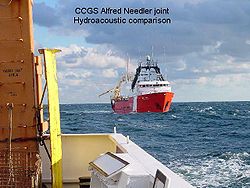
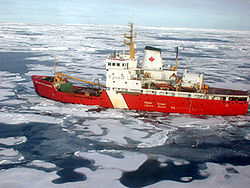



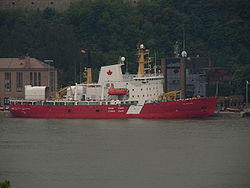
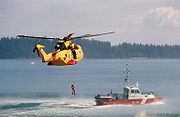

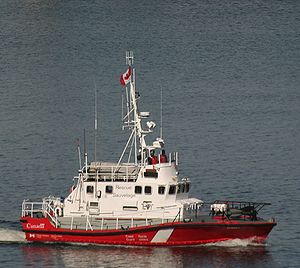
The Canadian Coast Guard
Canadian Coast Guard
The Canadian Coast Guard is the coast guard of Canada. It is a federal agency responsible for providing maritime search and rescue , aids to navigation, marine pollution response, marine radio, and icebreaking...
maintains a fleet of sea and lake going vessels, hovercraft
Hovercraft
A hovercraft is a craft capable of traveling over surfaces while supported by a cushion of slow moving, high-pressure air which is ejected against the surface below and contained within a "skirt." Although supported by air, a hovercraft is not considered an aircraft.Hovercraft are used throughout...
, and aircraft.
Vessels: ships and small boats
The Fleet Directorate is responsible for all ships and their manning requirements. It manages and operates a fleet of 114 vessels in support of: CCG aids to navigation; icebreaking; environmental response; and search and rescueSearch and rescue
Search and rescue is the search for and provision of aid to people who are in distress or imminent danger.The general field of search and rescue includes many specialty sub-fields, mostly based upon terrain considerations...
. The CCG fleet also supports DFO’s Fisheries Conservation and Protection and Marine Science programs.
The ships, ranging from search and rescue lifeboats to icebreakers, are tasked to various programs, often concurrently, and are crewed by 2400 skilled seagoing personnel. Most vessels have between 5-30+ crewmembers.
All CCG vessels are painted uniformly regardless of their use. They are characterized by a red hull and white superstructure, designed to look like a "floating Canadian flag". Their hulls bear a (primarily) white stripe raked forward at a 60 degree angle on each side forward. Larger vessels display a red maple leaf on the funnel. Ship nameplates are typically affixed to the superstructure, and vessels are typically named for persons or places of historic or geographic significance.
Throughout the 1960s–1990s, CCG painted primary SAR vessels in a different colour scheme: bright mustard yellow superstructure and maple leaf red hull, meant to distinguish them from navaid tenders and icebreakers, and also to improve their visibility on the open ocean in breaking waves. Today the only distinguishing markings for primary SAR vessels is the large RESCUE-SAUVETAGE lettering on the superstructure. Vessels carry the "Canada" 'federal wordmark', which incorporates the duotone version of the national flag. The words Coast Guard Garde Cotière appear side by side on the hull.
The prefix
Ship prefix
A ship prefix is a combination of letters, usually abbreviations, used in front of the name of a civilian or naval ship.Prefixes for civilian vessels may either identify the type of propulsion, such as "SS" for steamship, or purpose, such as "RV" for research vessel. Civilian prefixes are often...
"Canadian Coast Guard Ship", abbreviated CCGS, is affixed to all vessels. Minor vessels such as patrol boats and life boats carried the prefix "Canadian Coast Guard Cutter", abbreviated CCGC in the past, however, this is no longer the case.
The list of various classes of CCG vessels includes:
Polar Icebreakers
- In design stage.
Heavy Arctic Icebreakers
- Large powerful icebreaker approximately 130 metres long and is capable of sustained operations in the Canadian Arctic with minimal support, for the period of early June to mid-November, and for escort operation in the Gulf of St. Lawrence and East Coast of Newfoundland in the winter.
Arctic Icebreakers
- Large icebreaker of approximately 100 metres in length capable of sustained ice breaking and escort operations in the Arctic during the summer, and in the Gulf, St. Lawrence River and the Atlantic Coast in winter. It is also capable conducting scientific missions, has a small cargo carrying capacity and can carry a helicopter if needed. All four are T1200 Class vessels.
Coast Guard Program Vessels
- Large multi-taskable vessels approximately 85 metres long, with an icebreaking capability that allows them to work mainly in southern waters and in the western Arctic. All 7 vessels are T1100 Class vessels (using the same basic design with some variations in additional equipment).
Offshore Fishery and Oceanographic Research
- Large offshore vessels approximately 80 metres long that are multi-taskable to fishery and oceanographic missions, as well as geological and hydrographic surveys. These vessels have no icebreaking capabilities, are equipped with wet labs, trawl capability, bottom sampling capability and water column sampling capability, and can accommodate up to 26 scientists. Some ships are strengthened for navigation in ice to allow them to perform their task year round even when the waterways are not ice free.
Offshore Fishery Science
- Large offshore Science vessels that are multi-taskable to acoustic and environmental research. They are able to do trawl surveys and some water column sampling and are equipped with wet labs. Both ships are capable of performing year round, but they are not icebreakers.
Marine Service
- Multi-taskable, shallow draft vessels that are about 65 metres in length. They have some icebreaking capability (all but Bartlett) and can launch and recover Fast Response Craft. They are primarily used for aids to navigation, icebreaking, science and environmental response. CCGS Tracy is classed as Type 1000 vessel.
Offshore Patrol
- Patrol vessels of up to 60 metres in length and can operate year-round beyond 120 nautical miles, including outside 200 nautical mile Exclusive Economic Zone (except the Arctic). They carry 2 Rigid-hull Inflatable boats, and their main use is fisheries enforcement and search and rescue.
Mid-shore Patrol
- Medium sized patrol vessels of about 37 – 42 metres which operate up to 120 nautical miles offshore. These vessels carry one or two Rigid-hull Inflatable boats (depending on the variant design) and have accommodation for two fisheries or police officers. The main use is for maritime security and fisheries enforcement.
Hydrographic Survey
- These vessels are meant to carry out hydrographic survey work primarily for the production of nautical charting products on the East and West Coast, but can also be used for stock assessment using sonar.
Special Navaid Tenders
- Shallow draft, flat bottom vessels used for the placement and maintenance of fixed and floating navigational aids on the Mackenzie River. They are very specialized vessels that can sustain repeated groundings while they search for shifts in the channel and are not usually sent into open waters. CCGS Nahidik also performs ocean surveys in conjunction with Canadian universities and Natural Resources Canada in the Beaufort Sea.
Mid-shore Fishery Research
- Medium-sized vessels that are multi-taskable to fishery and oceanographic missions, as well as geological and hydrographic surveys. These vessels have no icebreaking capabilities, are equipped with wet labs, trawl capability, bottom sampling capability and water column sampling capability.
Channel Survey & Sounding
- Small twin-hull sounding vessels designed to conduct depth survey operations of the main shipping channel in the St. Lawrence River, between Île aux Coudres and Montreal during the period or spring break-up until end of November.
Air Cushion Vehicles (hovercraft
Hovercraft
A hovercraft is a craft capable of traveling over surfaces while supported by a cushion of slow moving, high-pressure air which is ejected against the surface below and contained within a "skirt." Although supported by air, a hovercraft is not considered an aircraft.Hovercraft are used throughout...
)
- Medium sized multi-taskable vehicles, which float on a cushion of air, making them capable of working over water (including very shallow water), land and ice . They are very fast vehicles (up to 60 knots), which makes them ideally suited for search and rescue, and environmental response where response time is critical. They are also used for icebreaking in shallow waters and in the St. Lawrence River for ice management.
SAR Motor Lifeboats (MLBs
Lifeboat (rescue)
A rescue lifeboat is a boat rescue craft which is used to attend a vessel in distress, or its survivors, to rescue crewmen and passengers. It can be hand pulled, sail powered or powered by an engine...
)
- Small shore-based self-righting lifeboats approximately 15 metre long, capable of search and rescue operations of up to 100 nautical miles with a top speed of approximately 25 knots. They carry a crew of four or five persons.
Near/Inshore Patrol Vessels
- Medium range with moderate speed, capable of operating in moderate weather conditions in sheltered waters - station mode.
Small CG Program Vessels
- Small multi-taskable vessels that have a shallower draft overall and are configured to service marine aids to navigation.and have no helicopter carrying capability
Training Vessels
- Vessels used for training at the Coast Guard CollegeCanadian Coast Guard CollegeThe Canadian Coast Guard College is a maritime training college and Canadian Coast Guard facility located in Westmount in the Cape Breton Regional Municipality, near Sydney, Nova Scotia, Canada....
. All three are small patrol boatPatrol boatA patrol boat is a relatively small naval vessel generally designed for coastal defense duties.There have been many designs for patrol boats. They may be operated by a nation's navy, coast guard, or police force, and may be intended for marine and/or estuarine or river environments...
s with a crew of 3.
Utility craft
- CCG employs various makes and models of small craft aboard ships and at shore stations for utility and search and rescue tasks. Large vessels carry work boats such as Rotork Marine's Sea Truck design, similar to small landing craftLanding craftLanding craft are boats and seagoing vessels used to convey a landing force from the sea to the shore during an amphibious assault. Most renowned are those used to storm the beaches of Normandy, the Mediterranean, and many Pacific islands during WWII...
, which are deployed by davits and used for delivering supplies ashore to light stations and remote communities. RHIBs equipped with outboard or inboard engine propulsion systems are deployed aboard CCG ships or at shore stations as tenders and as fast rescue craft (FRC) for utility and search and rescue tasks.
- Work boats
- Roseborough Boats RF-246 designs
- Rotork Marine Sea Truck designs
- Rigid hull inflatable boats (RHIBs)
- Zodiac Hurricane Mark IV, Mark V, Mark VI, 733 and 753 SOLAS designs
- Roseborough Boats Rough Water 9.11 SOLAS designs
Procurement
Many larger vessels in the CCG are close to the end of their planned lifetime, having been constructed from the 1960s–1980s with no replacements in the 1990s–2000s.-
- Polar 8 Project
- The Polar 8 ProjectPolar 8The Polar 8 Project was a Canadian shipbuilding project based upon a class of 167-metre, 101,000-horsepower, diesel-electric powered high endurance icebreakers intended for the Canadian Coast Guard. The project was developed as a means to assert Canada's sovereignty in the Arctic Ocean...
announced in 1985 would have built several $700 million (1985 CAD) icebreakers with polar classPolar classPolar class refers to the ice class assigned to a ship by a classification society. A Polar class ship refers to a ship for which a Polar class has been assigned....
of PC-1 for use in the Arctic OceanArctic OceanThe Arctic Ocean, located in the Northern Hemisphere and mostly in the Arctic north polar region, is the smallest and shallowest of the world's five major oceanic divisions...
. The project was canceled in 1990 in lieu of refitting .
-
- Mid Shore Patrol Vessel Project
- The Mid Shore Patrol Vessel Project will procure 9 vessels to supplement fisheries conservation and protection duties as well as marine security duties in Maritime, Newfoundland, Pacific, and Central and Arctic regions. It is expected that 4 of these vessels are to be tasked with marine security duties in Central and Arctic Region and will have an operating area in the Great Lakes - St. Lawrence Seaway. The initial procurement process for 12 ships was cancelled in 2008 when bids came in over budget; however a revised biDamen Stan patrol vessel 4708dding process was reissued in 2009. On September 2, 2009, Public Works and Government Services CanadaPublic Works and Government Services CanadaPublic Works and Government Services Canada is the department of the government of Canada with responsibility for the government's internal servicing and administration....
awarded a contract to Halifax Shipyards to build 9 (down from the original 12) mid-shore patrol vessels based on a 'Canadianized' version of the Damen Stan 4207 patrol vesselDamen Stan 4207 patrol vesselThe Damen Stan Patrol 4100, Damen Stan Patrol 4207 and Damen Stan Patrol 4708 are three related designs from the Damen Group, a Dutch shipbuilding firm.The Stan 4207 design are patrol vessels.They are wide, and can travel at 22 knots....
.
-
- Offshore Fisheries Science Vessel Project
- The federal government announced the Offshore Fisheries Science Vessel Project in 2006 to procure vessels that will be 67 meters in length and be capable of carrying 22 to 26 crew as well as 19 scientists. Two vessels were provided for in Budget 2006, with funding for an additional vessel added in Budget 2007. The procurement process for these vessels began in September 2009.
-
- Offshore Oceanographic Science Vessel Project
- The Offshore Oceanographic Science Vessel Project is a plan to procure a single vessel that will be 90-100 meters in length capable of carrying 30 crew as well as 37 scientists. It will replace the venerable and famous which has been Canada's major oceanographic research vessel for the past 40 years. Funds for the project were allocated in Budget 2007. The first phase of the procurement process for this vessel, along with the 3 offshore fisheries science vessels, was launched in September 2009 when the government issued a Solicitation of Interest and Qualification to identify qualified designers.
-
- Polar Class Icebreaker Project
- The February 2008 federal budget designated $720 million for the Polar Class Icebreaker Project to replace in FY 2017. In August 2008 the name for this project's sole vessel was announced as , however this vessel has not been designed, nor ordered as of September 2009.
-
- Inshore Fisheries Science Vessel Project
- The 2009 federal budget announced $175 million in funding for, among other things an Inshore Fisheries Science Vessel Project which will procure 3 new Inshore Fisheries Science Vessels. Two 18-metre vessels are to be based in Quebec region, while a third 24-meter vessel will be based in Maritime region (in New Brunswick). In June 2009, the government awarded a contract to Robert Allan Ltd.Robert Allan Ltd.Robert Allan Ltd. is Canada's oldest privately owned consulting Naval Architectural firm, established in Vancouver, British Columbia in 1930. Their experience includes designs for hundreds of vessels of almost all types, from small fishing boats to ocean-going ferries, however the firm is best...
of Vancouver, B.C. to design the vessels. The boats are expected to be delivered to the CCG by March 2011.
-
- Miscellaneous vessels and repair of existing vessels
- The funding announced in Budget 2009 also provided for the procurement of 98 small boats and barges for the CCG, as well as the life extension or repair of 40 of its larger vessels.
-
- Air Cushion Vehicle Project
- The Air Cushion Vehicle Project saw a new hovercraft, the , procured by CCG in 2009.
-
- Near Shore Fisheries Research Vessel Project
- The Near Shore Fisheries Research Vessel Project saw a single vessel procured for Central and Arctic Region, , which is currently based at the Canada Centre for Inland Waters, Burlington, OntarioBurlington, OntarioBurlington , is a city located in Halton Region at the western end of Lake Ontario. Burlington is part of the Greater Toronto Area, and is also included in the Hamilton Census Metropolitan Area. Physically, Burlington lies between the north shore of Lake Ontario and the Niagara Escarpment...
.
Retired Vessels
The following is a listing of vessels that are no longer part of the Canadian Coast Guard's present fleet.Aircraft
In addition to various bases located in deep water ports, rescue stations in smaller minor ports, and its fleet of vessels, CCG also operates 27 rotary and 22 fixed wing aircraft operated on CCG’s behalf by Transport CanadaTransport Canada
Transport Canada is the department within the government of Canada which is responsible for developing regulations, policies and services of transportation in Canada. It is part of the Transportation, Infrastructure and Communities portfolio...
. Rotary wing aircraft are used as ice surveillance platforms in the winter (operating from icebreakers and shore bases), while flying maintenance personnel and supplies for servicing aids to navigation year-round. Fixed wing aircraft are used for marine pollution surveillance and marine fisheries surveillance patrols.
The majority of CCG aircraft are stationed at municipal airports located near major CCG bases and are primarily located in eastern Canada, given the absence of ice surveillance requirements for the west coast.
-
- Fixed and rotary wing maintenance
- Ottawa Macdonald-Cartier International AirportOttawa Macdonald-Cartier International AirportOttawa/Macdonald-Cartier International Airport or Macdonald-Cartier International Airport , in Ottawa, Ontario, Canada is named after Sirs John A. Macdonald and George-Étienne Cartier...
(YOW), Ottawa, ON
- Ottawa Macdonald-Cartier International Airport
- Fixed and rotary wing maintenance
-
- Fixed wing operations and maintenance
- Vancouver International AirportVancouver International AirportVancouver International Airport is located on Sea Island in Richmond, British Columbia, Canada, about from Downtown Vancouver. In 2010 it was the second busiest airport in Canada by aircraft movements and passengers , behind Toronto Pearson International Airport, with non-stop flights daily to...
(YVR), Richmond, BCRichmond, British ColumbiaRichmond is a coastal city, incorporated in the Canadian province of British Columbia. Part of Metro Vancouver, its neighbouring communities are Vancouver and Burnaby to the north, New Westminster to the east, and Delta to the south, while the Strait of Georgia forms its western border... - Greater Moncton International AirportGreater Moncton International AirportGreater Moncton International Airport or Moncton/Greater Moncton International Airport is located in the city of Dieppe east northeast of downtown Moncton, New Brunswick, Canada...
(YQM), Dieppe, NBDieppe, New BrunswickDieppe is a Canadian city in Westmorland County, New Brunswick.-Geography:Dieppe is located on the Petitcodiac River east of the adjacent city of Moncton... - Iqaluit AirportIqaluit AirportIqaluit Airport serves Iqaluit, Nunavut, Canada and is located adjacent to the town. It is operated by the government of Nunavut. It hosts scheduled passenger service from Ottawa, Montreal, Rankin Inlet and Kuujjuaq on carriers such as First Air and Canadian North, as well as from smaller...
(YFB), Iqaluit, NUIqaluit, NunavutIqaluit is the territorial capital and the largest community of the Canadian territory of Nunavut. Iqaluit is located on the south coast of Baffin Island at the head of Frobisher Bay. As of the 2006 census the population was 6,184, an increase of 18.1 percent from the 2001 census; it has the... - Halifax Stanfield International Airport (YHZ), Halifax, NS
- St. John's International AirportSt. John's International AirportSt. John's International Airport is an international airport located northwest of St. John's, Newfoundland and Labrador, Canada that serves the St. John's Metro Area and the Avalon Peninsula. The airport is part of the National Airports System, and is operated by St...
(YYT), St. John's, NLSt. John's, Newfoundland and LabradorSt. John's is the capital and largest city in Newfoundland and Labrador, and is the oldest English-founded city in North America. It is located on the eastern tip of the Avalon Peninsula on the island of Newfoundland. With a population of 192,326 as of July 1, 2010, the St...
- Vancouver International Airport
- Fixed wing operations and maintenance
-
- Rotary wing operations and maintenance
- Stephenville International Airport (YJT), Stephenville, NLStephenville, Newfoundland and LabradorStephenville is a Canadian town in Newfoundland and Labrador on the west coast of the island of Newfoundland....
- St. John's International AirportSt. John's International AirportSt. John's International Airport is an international airport located northwest of St. John's, Newfoundland and Labrador, Canada that serves the St. John's Metro Area and the Avalon Peninsula. The airport is part of the National Airports System, and is operated by St...
(YYT), St. John's, NLSt. John's, Newfoundland and LabradorSt. John's is the capital and largest city in Newfoundland and Labrador, and is the oldest English-founded city in North America. It is located on the eastern tip of the Avalon Peninsula on the island of Newfoundland. With a population of 192,326 as of July 1, 2010, the St... - CFB ShearwaterCFB ShearwaterCanadian Forces Base Shearwater , commonly referred to as CFB Shearwater, was a Canadian Forces Base located in Shearwater, Nova Scotia on the eastern shore of Halifax Harbour in the Halifax Regional Municipality....
(YAW), Dartmouth, NSDartmouth, Nova ScotiaDartmouth founded in 1750, is a community and planning area of the Halifax Regional Municipality, Nova Scotia. Located on the eastern shore of Halifax Harbour, Dartmouth has been nicknamed the City of Lakes after the large number of lakes located in the city.On April 1, 1996, the provincial... - Saint John AirportSaint John AirportSaint John Airport is an airport located east northeast of Saint John, New Brunswick, Canada.Part of the National Airports System, it is owned by Transport Canada and operated by Saint John Airport Inc....
(YSJ), Saint John, NBSaint John, New BrunswickCity of Saint John , or commonly Saint John, is the largest city in the province of New Brunswick, and the first incorporated city in Canada. The city is situated along the north shore of the Bay of Fundy at the mouth of the Saint John River. In 2006 the city proper had a population of 74,043... - Charlottetown AirportCharlottetown AirportCharlottetown Airport, , is located north of Charlottetown, Prince Edward Island, Canada. The airport is currently run by the Charlottetown Airport Authority, is owned by Transport Canada and forms part of the National Airports System....
(YYG), Charlottetown, PEI - Parry Sound Area Municipal AirportParry Sound Area Municipal AirportParry Sound Area Municipal Airport, , is located southeast of Parry Sound, Ontario Canada.This airport serves both the Parry Sound community and as a passage to the north. Located just north of the top of Lake Joseph, it also offers a great fuel and rest point for pilots of smaller aircraft in the...
(YPD), Parry Sound, ONParry Sound, OntarioParry Sound is a town in Central Ontario, Canada, located on Parry Sound on the eastern shore of Georgian Bay. Parry Sound is located south of Sudbury and north of Toronto. It is the seat of Parry Sound District, a popular cottage country region for Southern Ontario residents. It is also the... - Victoria International AirportVictoria International AirportVictoria International Airport serves Victoria, British Columbia, Canada. It is north northwest of the city, in North Saanich, quite close to the town of Sidney on the Saanich Peninsula...
(YYJ), Sidney, BCSidney, British ColumbiaSidney is a town located at the northern end of the Saanich Peninsula, on Vancouver Island in the Canadian province of British Columbia. It is one of the 13 Greater Victoria municipalities. It has a population of approximately 11,300. Sidney is located just east of Victoria International Airport,... - Prince Rupert AirportPrince Rupert AirportPrince Rupert Airport, , is located west southwest of Prince Rupert, British Columbia, Canada.The airport is classified as an airport of entry by NAV CANADA and is staffed by the Canada Border Services Agency...
(YPR), Prince Rupert, BCPrince Rupert, British ColumbiaPrince Rupert is a port city in the province of British Columbia, Canada. It is the land, air, and water transportation hub of British Columbia's North Coast, and home to some 12,815 people .-History:...
- Stephenville International Airport (YJT), Stephenville, NL
- Rotary wing operations and maintenance
CCG's fixed wing operations and maintenance bases are co-located with Transport Canada aviation operations facilities. Maintenance for all CCG aircraft is provided by both CCG and Transport Canada
Transport Canada
Transport Canada is the department within the government of Canada which is responsible for developing regulations, policies and services of transportation in Canada. It is part of the Transportation, Infrastructure and Communities portfolio...
personnel.
As with any government vessels being called upon to assist Canadian Forces
Canadian Forces
The Canadian Forces , officially the Canadian Armed Forces , are the unified armed forces of Canada, as constituted by the National Defence Act, which states: "The Canadian Forces are the armed forces of Her Majesty raised by Canada and consist of one Service called the Canadian Armed Forces."...
Maritime Command
Canadian Forces Maritime Command
The Royal Canadian Navy , is the naval force of Canada. The RCN is one of three environmental commands within the unified Canadian Forces. Operating 33 warships and several auxiliary vessels, the Royal Canadian Navy consists of 8,500 Regular Force and 5,100 Primary Reserve sailors, supported by...
, government civilian aircraft such as CCG aircraft may be called upon at any time to assist Canadian Forces
Canadian Forces
The Canadian Forces , officially the Canadian Armed Forces , are the unified armed forces of Canada, as constituted by the National Defence Act, which states: "The Canadian Forces are the armed forces of Her Majesty raised by Canada and consist of one Service called the Canadian Armed Forces."...
Air Command
Canadian Forces Air Command
The Royal Canadian Air Force , formerly Canadian Forces Air Command, is one of three environmental commands of the Canadian Forces...
.
! style="text-align: left; background: #aacccc;"|Aircraft
! style="text-align: left; background: #aacccc;"|Origin
! style="text-align: left; background: #aacccc;"|Type
! style="text-align: left; background: #aacccc;"|Versions
! style="text-align: left; background: #aacccc;"|In service
! style="text-align: left; background: #aacccc;"|Notes
|-
| MBB Bo 105
|
| rotary wing
|
| 16
| ship-based and shore-based ice surveillance, navigation aid maintenance
|-
| Bell 407
Bell 407
The Bell 407 is a four-blade, single-engine, civil utility helicopter; a derivative of the Bell 206L-4 LongRanger. The 407 uses the four-blade rotor with composite hub developed for the United States Army's OH-58D Kiowa Warrior instead of the two-blade, semi-rigid rotor of the 206L-4...
|
| rotary wing
|
| 2
| shore-based ice surveillance, navigation aid maintenance
|-
| Bell 212 Twin Huey
|
| rotary wing
|
| 4
| shore-based ice surveillance, navigation aid maintenance
|-
| Bell 206 JetRanger
Bell 206
The Bell 206 is a family of two-bladed, single- or twin-engine helicopters, manufactured by Bell Helicopter at its Mirabel, Quebec plant. Originally developed as the Bell YOH-4 for the United States Army's Light Observation Helicopter program, the 206 failed to be selected...
|
| rotary wing
|
| 6
| shore-based ice surveillance, navigation aid maintenance
|-
| Sikorsky S-61
Sikorsky S-61
The Sikorsky S-61L and S-61N are civil variants of the successful SH-3 Sea King helicopter. They are two of the most widely used airliner and oil rig support helicopters built.-Design and development:...
|
| rotary wing
| S-61N
| 1
| navigation aid maintenance - Aircraft was retired Nov 2010.
|-
| de Havilland Canada Dash 8
|
| fixed wing
|
| 2
| marine pollution surveillance
|-
| Beech Super King Air B200
Beechcraft Super King Air
The Beechcraft Super King Air family is part of a line of twin-turboprop aircraft produced by the Beech Aircraft Corporation . The King Air line comprises a number of model series that fall into two families: the Model 90 series, Model 100 series , Model 200 series and Model 300 series...
|
| fixed wing
|
| 3
| marine fisheries and marine pollution surveillance
|-
| de Havilland Canada DHC-6 Twin Otter
De Havilland Canada DHC-6 Twin Otter
The DHC-6 Twin Otter is a Canadian 19-passenger STOL utility aircraft developed by de Havilland Canada and currently produced by Viking Air. The aircraft's fixed tricycle undercarriage, STOL abilities and high rate of climb have made it a successful cargo, regional passenger airliner and MEDEVAC...
|
| fixed wing
|
| 1
| marine pollution surveillance
|-
| de Havilland Canada Dash 7
De Havilland Canada Dash 7
The de Havilland Canada DHC-7, popularly known as the Dash 7, is a turboprop-powered regional airliner with STOL capabilities. It first flew in 1975 and remained in production until 1988 when the parent company, de Havilland Canada, was purchased by Boeing and was later sold to Bombardier...
|
| fixed wing
|
| 1
| marine pollution surveillance

